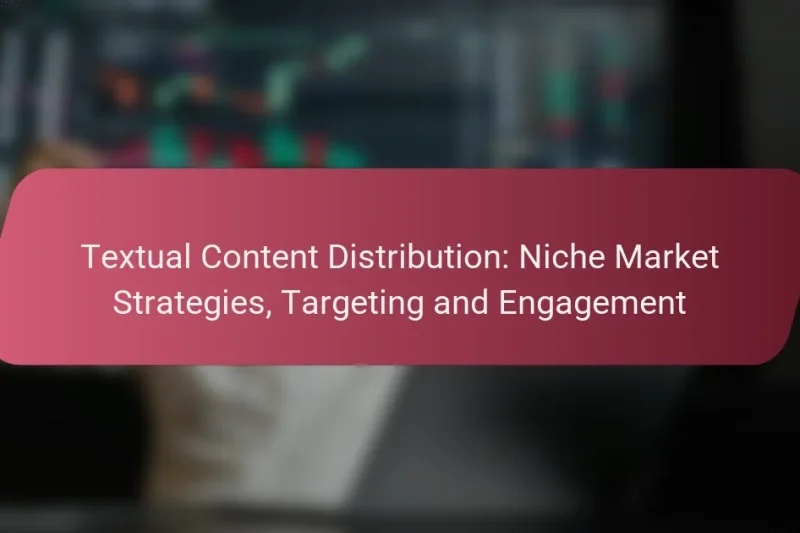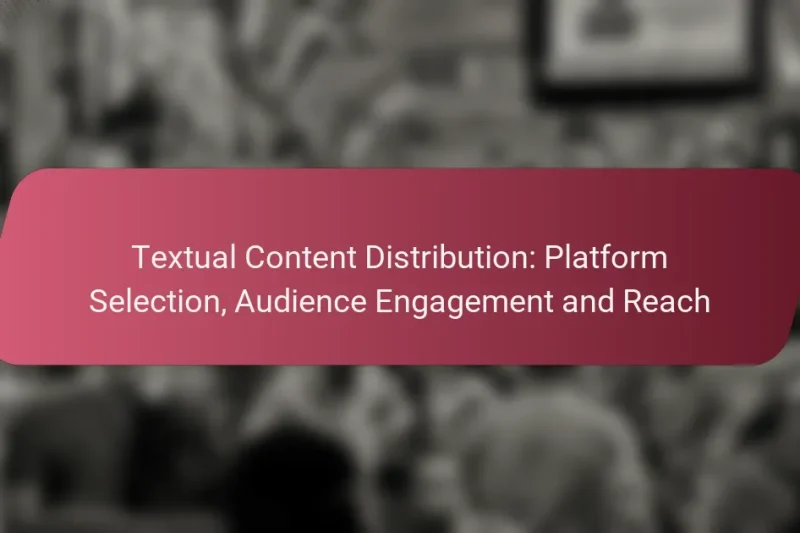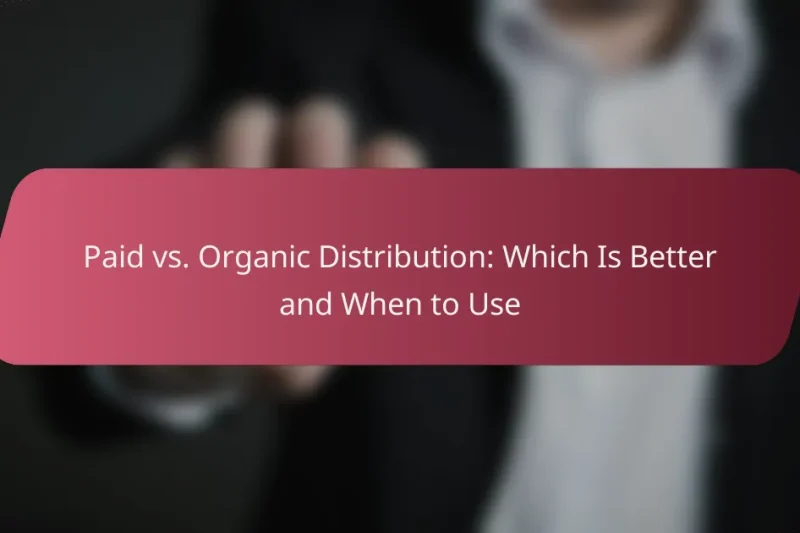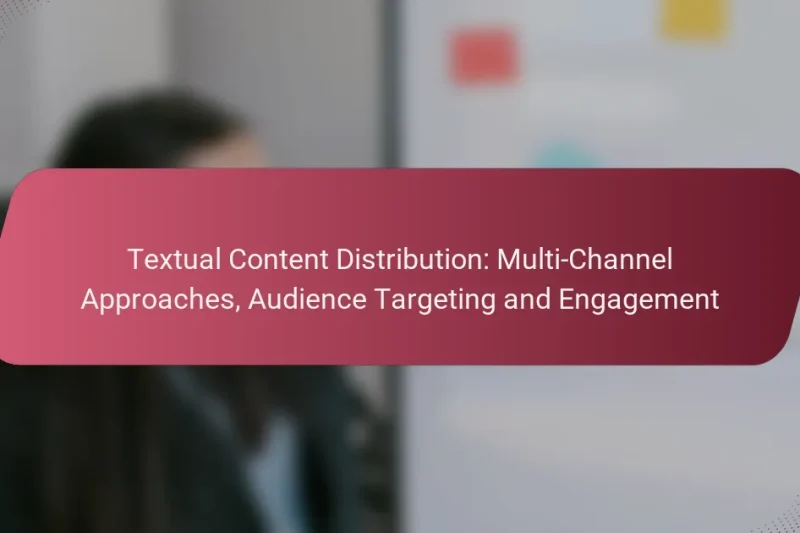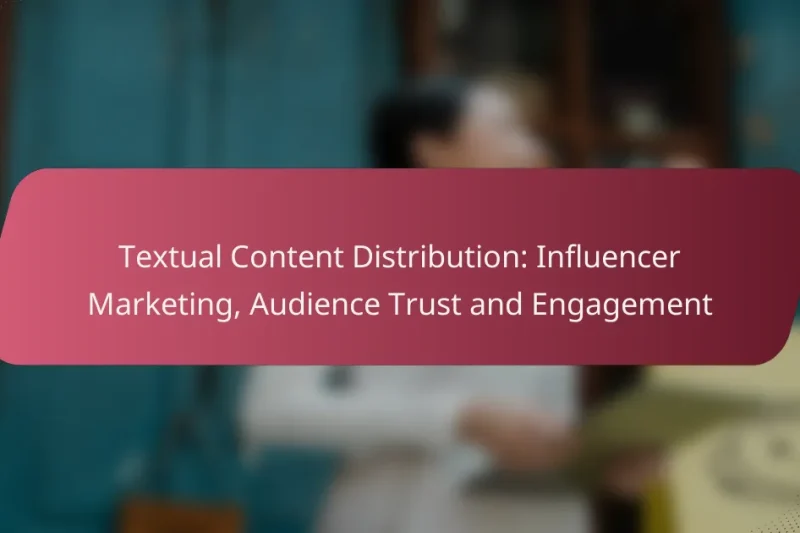Content distribution analytics is essential for measuring the effectiveness of your content across various channels, focusing … Content Distribution Analytics: Performance Tracking, Optimization and InsightsRead more
Content Distribution Channels
Content distribution channels are essential for businesses looking to effectively reach and engage their target audiences. These channels, which include social media, email marketing, and influencer partnerships, each offer unique advantages that require tailored strategies. By understanding your audience and evaluating the effectiveness of various platforms, you can ensure your content reaches the right people at the right time.
Textual Content Distribution: Niche Market Strategies, Targeting and Engagement
In the realm of niche market strategies, effective textual content distribution hinges on targeted approaches that … Textual Content Distribution: Niche Market Strategies, Targeting and EngagementRead more
Content Syndication: Reach Expansion, Audience Growth and Brand Visibility
Content syndication is a powerful strategy for enhancing brand visibility by distributing your content across multiple … Content Syndication: Reach Expansion, Audience Growth and Brand VisibilityRead more
Textual Content Distribution: Platform Selection, Audience Engagement and Reach
Effective textual content distribution hinges on selecting the right platforms tailored to your target audience and … Textual Content Distribution: Platform Selection, Audience Engagement and ReachRead more
Paid vs. Organic Distribution: Which Is Better and When to Use
In the digital marketing landscape, choosing between paid and organic distribution is crucial for maximizing content … Paid vs. Organic Distribution: Which Is Better and When to UseRead more
Textual Content Distribution: Multi-Channel Approaches, Audience Targeting and Engagement
In today’s digital landscape, multi-channel content distribution is essential for brands aiming to engage their audiences … Textual Content Distribution: Multi-Channel Approaches, Audience Targeting and EngagementRead more
Textual Content Distribution: Influencer Marketing, Audience Trust and Engagement
Influencer marketing plays a crucial role in enhancing audience trust by utilizing the credibility of trusted … Textual Content Distribution: Influencer Marketing, Audience Trust and EngagementRead more
What are the best content distribution channels for businesses?
The best content distribution channels for businesses include social media platforms, email marketing, content syndication networks, influencer partnerships, and SEO-focused blogs. Each channel offers unique advantages and requires specific strategies to effectively reach and engage target audiences.
Social media platforms
Social media platforms like Facebook, Instagram, LinkedIn, and Twitter are essential for distributing content due to their vast user bases. Businesses can share articles, videos, and infographics to engage followers and drive traffic to their websites.
To maximize impact, tailor content to each platform’s audience and format. For instance, use visually appealing images on Instagram and professional insights on LinkedIn. Regular posting and interaction with followers can enhance visibility and engagement.
Email marketing
Email marketing remains a powerful channel for content distribution, allowing businesses to reach subscribers directly. By sending newsletters, promotional offers, or personalized content, companies can maintain relationships and encourage repeat visits.
To optimize email campaigns, segment your audience based on interests and behaviors. Use compelling subject lines and clear calls to action to improve open and click-through rates. Aim for a consistent schedule without overwhelming subscribers.
Content syndication networks
Content syndication networks, such as Outbrain or Taboola, help businesses distribute their content across various websites. This method increases visibility and can drive significant traffic back to the original content.
When using syndication, ensure your content is high-quality and relevant to the target audience. Monitor performance metrics to adjust strategies and maximize return on investment. Be mindful of potential costs associated with syndication services.
Influencer partnerships
Partnering with influencers can amplify content reach by leveraging their established audiences. Influencers can share your content through their channels, providing authenticity and credibility to your brand.
Choose influencers whose values align with your brand and whose audience matches your target market. Collaborate on content creation to ensure it resonates with their followers. Track engagement metrics to evaluate the effectiveness of these partnerships.
SEO-focused blogs
SEO-focused blogs are crucial for organic content distribution, as they help improve search engine rankings and drive traffic. By creating valuable, keyword-rich content, businesses can attract visitors actively searching for relevant information.
Regularly update your blog with fresh content and optimize for SEO best practices, such as using appropriate keywords, meta tags, and internal linking. Consider guest blogging to expand reach and build backlinks, enhancing overall site authority.
How to choose the right content distribution channel?
Choosing the right content distribution channel involves understanding your audience, evaluating the effectiveness of various platforms, and analyzing competitors. This strategic approach ensures that your content reaches the right people at the right time.
Identify target audience
Understanding your target audience is crucial for selecting an appropriate content distribution channel. Consider demographics such as age, location, interests, and online behavior. Tools like surveys and analytics can help gather insights about your audience’s preferences.
Once you have a clear picture of your audience, tailor your content to resonate with them. For example, younger audiences may prefer platforms like TikTok or Instagram, while professionals might engage more on LinkedIn.
Evaluate channel effectiveness
Assessing the effectiveness of different distribution channels is essential for maximizing your content’s reach. Look at metrics such as engagement rates, conversion rates, and audience growth on each platform. This data helps identify which channels yield the best results.
Consider conducting A/B testing to compare the performance of various channels. For instance, you might find that email newsletters generate higher conversions than social media posts, guiding your future distribution efforts.
Analyze competitor strategies
Studying competitor strategies can provide valuable insights into successful content distribution. Identify where your competitors are active and how they engage their audience. Tools like SEMrush or Ahrefs can help analyze their online presence and content performance.
Look for gaps in their strategies that you can exploit. If competitors are not utilizing a specific channel effectively, it may present an opportunity for you to reach your target audience more effectively.
What are the benefits of using multiple distribution channels?
Using multiple distribution channels allows businesses to maximize their content’s visibility and reach a broader audience. By diversifying where and how content is shared, companies can enhance engagement and effectively target different segments of their audience.
Increased reach
Utilizing various distribution channels significantly boosts the reach of your content. Each platform has its own user base, and by leveraging multiple channels, you can tap into different demographics and interests. For example, sharing content on social media, email newsletters, and blogs can collectively increase exposure by reaching thousands or even millions of potential viewers.
To maximize reach, consider the characteristics of each channel. For instance, platforms like Instagram and TikTok are ideal for visual content, while LinkedIn is better suited for professional articles and B2B communications. Tailoring your content to fit each platform can further enhance visibility.
Enhanced engagement
Engaging with your audience through multiple channels fosters a deeper connection. Different platforms offer unique ways for users to interact with content, such as comments, shares, and likes. This interaction not only increases visibility but also builds community around your brand.
To enhance engagement, encourage audience participation by asking questions or prompting discussions. For instance, a blog post can be complemented by a social media poll or a video Q&A session. This multi-faceted approach keeps your audience invested and encourages them to share your content with their networks.
Diverse audience targeting
Multiple distribution channels enable targeted messaging to various audience segments. Each channel attracts different demographics, allowing for tailored content that resonates with specific groups. For example, younger audiences may prefer platforms like Snapchat, while older demographics might engage more on Facebook.
When targeting diverse audiences, analyze the preferences and behaviors of each segment. Use analytics tools to track engagement and adjust your strategy accordingly. Creating content that speaks directly to the interests and needs of each audience can significantly improve conversion rates and brand loyalty.
What are the costs associated with content distribution?
The costs associated with content distribution can vary widely based on the chosen channels and strategies. Key expenses typically include paid advertising, subscription fees for platforms, and resource allocation for management.
Paid advertising expenses
Paid advertising expenses can significantly impact your overall content distribution budget. Costs can range from a few cents per click for social media ads to hundreds of dollars for premium placements on popular platforms. It’s essential to set a clear budget and monitor the return on investment (ROI) to ensure that your spending aligns with your goals.
Consider testing different ad formats and targeting options to find the most cost-effective strategies. For instance, running A/B tests can help identify which ads perform best, allowing you to allocate funds more efficiently.
Subscription fees for platforms
Subscription fees for content distribution platforms can vary based on features and audience size. Many platforms offer tiered pricing, with basic plans starting from around $10 to $50 per month, while advanced features can cost several hundred dollars monthly. Evaluate your needs to choose a plan that provides the best value for your content distribution efforts.
Keep in mind that some platforms may charge additional fees for premium features, analytics, or increased reach. Always read the fine print to avoid unexpected costs that could impact your budget.
Resource allocation for management
Resource allocation for management involves dedicating time and personnel to oversee content distribution. This can include hiring staff or outsourcing to agencies, which can range from a few hundred to several thousand dollars per month, depending on the scope of work. Assess your internal capabilities to determine if you need additional support.
Effective management can lead to better performance and optimization of your content distribution strategy. Consider using project management tools to streamline processes and ensure that resources are used efficiently.
What metrics should be tracked for content distribution?
Tracking the right metrics for content distribution is essential for evaluating performance and optimizing strategies. Key metrics include engagement rates, traffic sources, and conversion rates, each providing insights into how well content resonates with audiences and drives desired actions.
Engagement rates
Engagement rates measure how actively users interact with your content. This can include likes, shares, comments, and time spent on a page. High engagement rates often indicate that the content is relevant and appealing to the audience.
To calculate engagement rates, divide the total interactions by the total reach or impressions, then multiply by 100 to get a percentage. Aim for engagement rates above 1-2% for social media and around 5-10% for email campaigns, as these figures can vary widely by industry.
Traffic sources
Traffic sources identify where your audience is coming from, such as organic search, social media, referrals, or direct visits. Understanding these sources helps in allocating resources effectively and refining content distribution strategies.
Utilize tools like Google Analytics to break down traffic sources. For example, if a significant portion of traffic comes from social media, consider increasing your promotional efforts on those platforms. Regularly review these sources to adapt to changing audience behaviors.
Conversion rates
Conversion rates indicate the percentage of users who complete a desired action, such as signing up for a newsletter or making a purchase. This metric is crucial for assessing the effectiveness of your content in driving business goals.
To calculate conversion rates, divide the number of conversions by the total visitors and multiply by 100. A good benchmark for conversion rates varies by industry but typically falls between 2-5%. Focus on optimizing calls-to-action and landing pages to improve these rates.
How can local businesses leverage content distribution?
Local businesses can effectively leverage content distribution by utilizing various channels to reach their target audience. This involves sharing valuable content through platforms that resonate with local consumers, enhancing visibility and engagement.
Target local social media groups
Engaging with local social media groups allows businesses to connect directly with their community. These groups often consist of residents who share interests, making them ideal for promoting local events, products, or services.
To effectively target these groups, businesses should identify relevant platforms such as Facebook or Nextdoor. Joining groups that align with their offerings and actively participating in discussions can foster trust and encourage word-of-mouth referrals.
When posting, ensure that content is tailored to the group’s interests. For instance, sharing local success stories or promotions can resonate well. Avoid overly promotional language; instead, focus on building relationships and providing value to the community.
